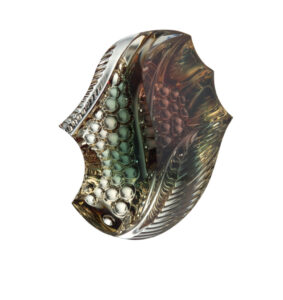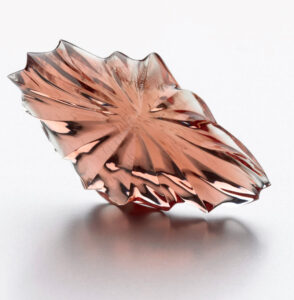By Jennifer Heebner, Editor in Chief
On January 20 this year, ownership of Dust Devil Mining, one of myriad active claims of Sunstone in Oregon, changed hands, with the new guard looking to do what past ones hadn’t: elevate the status of the feldspar mineral in the gemological world.

Sunstone is abundant worldwide and is found in yellow, champagne, red, and bicolor watermelon shades. However, the Oregon variety is the only one bearing copper, which causes the pink schiller effect. Gemologists call it aventurescence, the phenomenon of light reflecting off mineral platelets inside gemstones, thereby eliciting sparkle.
Collectors and cutters have a history of love for its earthy tones and scintillating effects. Many reports confirm that Tiffany & Co. used to own an Oregon Sunstone mine, calling select gems “Plush Diamonds” for their closeness to the town of Plush, Ore., and their sparkle. High-end jewelry designers like Erica Courtney have even been known to set them in her karat gold and diamond-encrusted creations, and top gem cutters love the material for its character.
Award-winning gem cutter Dalan Hargrave has cut many Sunstone specimens, including a 650 ct. piece from Dust Devil. Sunstone offers a lovely range of colors and effects. From reds, green, peachy pinks, and schiller-intense gems and watermelon hues, there are numerous shades to intrigue collectors. Hargrave loves the gem because every piece is unique, and schiller-rich Sunstones have even been known to cat’s eye when cut.
“Depending on the axis selected, you have some choice in how you want it to face up,” he says. “That, to me, is one of its most unique attributes.”

Dust Devil History
Don and Patsy Buford are now former owners of the mine, located on Bureau of Land Management Road No. 6115 in a remote stretch of Lake County, Oregon. Dust Devil is about 70 miles northeast of the town of Lakeview, which has a population of less than 2,500; sits on a claim totaling 20.66 acres; and is surrounded by miles of Sunstone-rich grounds. Surrounding mines include Spectrum Sunstone Mine and Double Eagle as well as some smaller and less active claims. Buford filed on the Dust Devil Mine claim back in 1992, as a former marine and Vietnam vet who started a lapidary program for Boy Scouts and Girl Scouts.
“It was really hard to find good stones for the kids to work with,” he recollects. He and a friend went in search of abandoned mining claims for a steady supply and stumbled across the Dust Devil site. A few years into claim ownership, the Scouts’ interest waned as Buford’s kicked into high gear. He quit a trucking job to move out to the mine site seasonally starting in 1996.
“It was a hobby that got out of hand,” he laughs.


Awards, Sales & Pricing
With some heavy-duty mining equipment, including 3- and 4-foot sorters, Buford and his wife extracted material to sell in Tucson and other regional fairs. It was his sales at the Gem & Jewelry Exchange (GJX) show and the 22nd Street shows in Tucson, however, that really helped build up his name and business. To maximize exposure, he gave away large specimens to high-profile cutters like Hargrave, William Cox, Larry Woods, and others, who have won 19 AGTA Spectrum & Cutting Edge Awards with material from his mine.


“It’s publicity money can’t buy,” he says.
Designer Brenda Smith even mined on site one season, found rough she loved, and had it cut by award-winning Darryl Alexander. He cut a 75.0 ct. flame, which Smith then made the focal point of both a necklace and an object of art. Her “Light My Fire” necklace featured matchstick motifs in silver and gold, and the flame was removeable for placement in a sculpture with Mexican Fire Opal ember and opalized and petrified ‘logs’ on an oxidized copper firebox base. The creations earned her an Honorable Mention in the 2016 Spectrum & Cutting Edge AwardsTM Objects of Art division.
Like every gemstone, Sunstone prices vary by grade and size. Champagne-color material between 2 and 5 carats start at $40 keystone per carat while anything over 5 carats is a minimum of $150 keystone per carat.

Sunstone with copper schiller (orangey to red tones) starts at $50 keystone per carat for smaller stones and can fetch as much as $100 keystone per carat in larger sizes. Grades of schiller also affect price: A has the least amount of schiller flash, while AAA has the most.
Meanwhile, some deeply saturated reds and bicolor material can command even greater sums. “I once sold a 24.89 ct. Sunstone for $50,000 keystone,” says Buford.

New Management
New Dust Devil owner Nicholas Johnson and his family fell hard for the beauty of Sunstone and the thrill of the hunt for it on their first mine visit, in March 2022. They returned two weeks later for more fun finding schillers “raining out of an open pit,” he says. “We kept breaking rocks and pulling out these amazing stones. It was kind of like an Easter egg hunt.”

Johnson’s day job is selling commercial signs for a large U.S. manufacturer, but he and his family were so hooked on the Dust Devil mine experience that he decided to buy it. An older brother with a background as an aggregate miner will move to Dust Devil to help manage it along with a longtime foreman who is familiar with its equipment and procedures. The Johnsons’ goal is to apply commercial mining practices to improve efficiency and volume of available material.
Buford hasn’t sold that much rough because fee diggers take most. Fee diggers like the Johnson family once was pay a day rate to dig for Sunstone specimens to keep. “There’s been virtually no production recently except for the fee diggers, which cover company expenses,” he says. Plus, Buford is at an age (75) when he’s ready to dial back his schedule.

Over his career as mine owner, he’s been written up by countless trade publications and even used to advertise. Still, even those efforts and the publicity generated by Cutting Edge wins weren’t enough to give the gem a higher station, a situation Johnson hopes to change.
“I want to wholesale the excess material we extract, and my goal is that Sunstones rise to the top of the list of sought-after gems,” says Johnson. “Most stores don’t know about it, but I’m hoping my signage, sales, and marketing skills will bring it to the next level.”

Photo by Andrew Hargrave
Promotional Efforts
Plans to put Sunstone on a pedestal include continued partnerships with cutters and jewelry designers and branded lines of jewelry. For the first year, Johnson will simply clean house and modernize certain aspects of the business, then he’ll shift gears to industry outreach.


“We want to extract enough rough to create a supply,” he says.
Then, he’ll approach big names like Chopard, and he even aims to try to rekindle the Tiffany & Co. connection. Seasoned types in jewelry may scoff at Johnson’s reach-for-the-stars enthusiasm, and he is already learning how to navigate rejection. A high-end New York–based jewelry store to which he sold signage turned down his offer of sending them Sunstones gratis. Ouch—that stung but didn’t deter him. His passion for the pretty gem will for sure fuel future pitches.
“So many have tried for so long to get Sunstone on the front burner,” says Johnson. “We know it’s a contender for its quality.”
This is proprietary content for AGTA and may not be reproduced.
For more information about Sunstone, check out Part I, Part II, and Part III of GIA’s A Sunstone Odyssey articles circa 2013.
